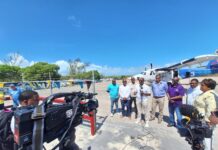When will the government we elect nationalize all natural resources for the benefit of the Bahamian people?

Some history about oil exploration in the Bahamas – Could this be the reason why the BNT wants all that land around Andros?
by http://www.bpcplc.com/about-us/about-the-bahamas/licence-history.aspx
Exploration of the waters of The Commonwealth of The Bahamas and vicinity occurred essentially continuously from post World War II, in the mid 1940s, until 1988 with exploratory well tests, occurring approximately every twelve years. Compared to the modern day, technologies used and survey techniques were primitive and well locations were defined by bathymetry and the utilisation of jack-up rigs rather optimising subsurface intersection. Now with Bahamas Petroleum Company’s tenure, modern technologies are being employed in an attempt to finally fully realize the potential of these waters.
Early exploratory activities in the mid to late Forties comprising small, local gravity and magnetic surveys were performed on contract for such companies as Gulf Oil, Standard Oil (Chevron), Superior Oil and Shell. This early activity was designed to highlight basin architecture rather than define specific structures or targets but did result in the drilling of the first Bahamian well (Andros Island #1), drilled onshore on Andros Island designed to a target depth (“T.D.”) of 14583 feet. The well was plugged and abandoned with no significant hydrocarbon shows reported.
From 1948 to 1955, the region experienced only limited exploratory activity, though Gulf, in 1948 and 1950, did attempt the first experimental underwater seismic and gravity surveys. Regionally, the Gulf 826-Y well was drilled west of Key West, Florida, notable as the well flowed 18 barrels of 22-24API gravity crude oil from an interval of anhydrite and carbonate (below 10,000ft) similar to those anticipated within the Bahamas Petroleum Company southern licences.
In 1956, Bahamas California Co. (Chevron) and Bahamas Exploration Co. (Gulf) performed a detailed seismic and engineering survey of the Cay Sal Bank area culminating in the second exploration well conducted in The Bahamas, the Cay Sal #1 (T.D. 18906 feet). The well was a joint test by the two companies drilled in 1959 encountering “live oil shows” from 12682 feet to T.D., but with no commercial quantities of hydrocarbons tested.
From 1959 to 1968, up to eight companies held the entire Bahamas region under concession. Gulf and Chevron led the majority of the exploratory activity by completing many experimental marine seismic programs (including the use of dynamite as an energy source). The lack of success in the acquisition of this primitive poor quality marine seismic data in the bank regions did not encourage well tests during this period.
In 1970, Gulf, Chevron and Mobil drilled a joint test, the Long Island #1 well (T.D. 17,577 feet), though this well was plugged and abandoned after having encountered live hydrocarbon shows at a depth of approximately 15,900 feet. The rig was then moved to the Great Isaac Bank where the Great Isaac #1 well was drilled by Chevron to a total depth of 17,847 feet. This well did encounter live hydrocarbon shows in the 16,900 feet to 17,700 feet depth interval with an over pressured reservoir containing gassy water at 17,436 to 17,495 feet depth interval. However, no commercial quantities of hydrocarbons were reported on tests.
From 1970 to 1983, industry exploratory activity involved new digitally-based seismic, gravity and magnetic surveys. Academic institutions and the Deep Sea Drilling Project were actively involved in attempting to understand the nature of the carbonate bank of The Bahamas through the acquisition of subsea and subsurface samples as well as new seismic and potential field data.
During the early 1980s a number of companies vied for competitive licence positions in Bahamian waters such that by 1984 the companies strongly represented included Esso, Amoco, Tenneco, Texaco, Arco, Breoco and Shell. In 1985, industry exploratory activity included the completion of then state-of-the-art seismic surveys, gravity and magnetic surveys, surface and subsea geochemical surveys, and geotechnical site surveys. Tenneco Oil Company was the leader in employing the greatest amount and variety of exploratory surveys. Further, during this time the international scientific Ocean Drilling Program drilled a series of tests to gather shallow subsurface data.
By late 1986, Tenneco had decided to spud the Doubloon Saxon #1 well; the deepest test drilled in The Bahamas to date and located within the current day Donaldson licence area. The well was successfully drilled to 21,740 feet, T.D’ing in the early Cretaceous above the regional Jurassic source rock intervals. The well encountered a number of live oil shows over a thick interval but did not report commercial quantities of hydrocarbons. Through the Cretaceous, and especially below the Aptian level, sequences of carbonates, fractured dolomites and anhydrites were encountered in multiple potential, reservoir sequences. These units, with around 20 in number where log quality allowed evaluation,, represented repeating units generally over 200′ thick. The well was drilled using a shallower water jack-up rig. Our reexamination of the targeted structure has concluded that whilst a successful drilling operation was conducted the well did not target a valid trap.
Following this significant exploratory test, licence interests remained with Tenneco and Shell (Shell having acquired Arco’s position). Subsequently additional post-drilling seismic surveys were performed by Tenneco and Shell during 1986 and 1987 but all licences were allowed to expire in 1988 so as to avoid incurring a significant work obligation for 1989 of $250m, and due to the then prevailing low oil prices (<$20/bbl).
Overall, the well results indicate the presence of a active petroleum systems, based on the presence, especially in the pre-mid Cretaceous sections, of oil shows of varying quality, abundant reservoirs and seals, indications of source rocks, and hydrocarbon saturations from log interpretation. Carbonates, the major component rocks of this region, globally contain 60% of the world’s oil but are not often encountered by nor best understood by many of todays major and independent oil companies. So now, into the modern era of new 3D technologies, deeper water drilling equipment becoming commonplace, escalating oil prices and sustained demand, Bahamas Petroleum Company has the opportunity to complete the exploration of this exciting potential hydrocarbon province.









